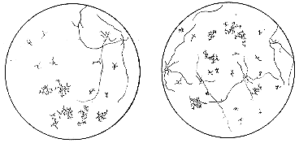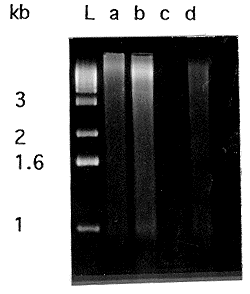IntroductionThe term phagocytosis itself describes its mean phage = engulfment; cytosis: cell process. In other words phagocytosis is the cellular process of engulfing solid particles by the cell memb ...
The following protocol has been used successfully to 15N or 13C/15N label our proteins using our pET1120/BL21(DE3) expression system: Preparing M9 minimal media begins with preparing a 5x stock soluti ...
1. Warm plates to room temperature before use. Cold plates causes the top agar to solidify irregularly. DO not warm plates to 37° as the top agar will take forever to solidify.2. Prepare top agar as t ...
1. For rich media weigh out appropriate ingredients and place into a flask. Add water until appropriate volume. Use a flask at least 2 times larger than the media volume.2. For minimal medium make sep ...
Prepare media and add 1.5 agar before autoclaving it (15g per liter). After autoclavation cool the media in a 55 degree waterbath. Do not allow the solution to cool below this temperature as the agar ...
Recipes: 1) LB BrothMake 16 gm of LB Broth Base (Gibco #M27800C) up to 800 ml in ddH2O. Swirl to dissolve then add 110 µl of 10 N NaOH. Autoclave.2) NZY BrothCombine: NaCl ...
AMPICILLIN Beta-lactam-antibiotics are not very stable when dissolved. Slow but steady degradation happens even when frozen to -20°C. Therefore commercial beta-lactam-antibiotics are sold as dried p ...
Grow cells overnight in 500 ml broth medium. Pellet cells by centrifugation and resuspend in 5 ml 50 mM Tris (pH 8.0) 50 mM EDTA. Freeze cell suspension at -20C Add 0.5 ml 250 mM Tris (pH 8.0) 10 mg/m ...
Stabilize RNAStart with 15 ml E. coli Culture containing 7.undefined 109 cells (OD600= 0.2 Dilute cells or scale up)Pipet 30 ml of RNAProtect Bacteria Reagent (Qiagen) into a 50ml polypropylene conical tube. ...
Note: This procedure does not work well with Gram + cocci. Transfer 1.5 mL overnight culture to a 1.5 mL microfuge tube centrifuge for 30 sec decant supernatant.Resuspend cells in 400 mL TE by vortexi ...
Part A. Isolation of Nucleic AcidsNOTE: CAUTION! STEPS 1-10 SHOULD BE PERFORMED USING APPROPRIATE PROCEDURES FOR HANDLING MATERIAL POTENTIALLY CONTAMINATED WITH MYCOBACTERIUM TUBERCULOSIS. ALSOTHE LID ...
3 g nodules (fresh or frozen in liquid N2) were ground to a powder in mortar and pestle with liquid N2. To the powder was added ice cold 0.5 M mannitol (or sucrose) 0.05 M Tris (pH 7.5) 0.02 M Na succ ...
DNA Preparation E. coli chromosomal DNA is prepared following the method of Heath et al. ( J. Bacteriol. 174 1992). Cells are embedded in agarose then treated with deter gents and enzymes which remove ...
Some of these notes describe what may be established routines in older laboratories but are either unpublished or published in inaccessible places or scattered through the old literature and thus may ...
Isolation of DNA from filamentous fungi for PCR analysis is usually time consuming and involves use of toxic chemicals such as phenol/chloroform. In Saccharomyces cerevisiae PCR assay can be performed ...
It is well known that multiple auxotrophic markers impede fruiting in Coprinus cinereus. Restriction fragment length polymorphisms have been used to advantage (Cassidy et al. 1984 Curr. Genet. 8:607-6 ...
OverviewHigh throughput of many fungal isolates can be achieved by growing axenic cultures in either (a) 1.5mL microfuge tubes half full with liquid media (500uL) with a hole punched through the top f ...
Three transformation systems have been reported for the rice blast fungus Magnaporthe grisea (Parsons et al. 1987 Proc. Natl. Acad. Sci. USA 84:4161-4165; Daboussi et al. 1989 Curr. Genet. 15:453-456; ...
Human-pathogenic fungi such as Coccidioides immitis and Histoplasma capsulatum must be handled in Biosafety level 3 containment facilities which make for a very awkward working environment (J.Y. Richm ...
The polymerase chain reaction (PCR) is a method for amplifying specific segments of DNA defined by the small primers used to start the reaction. Using arbitrarily chosen 10-base primers one can genera ...







